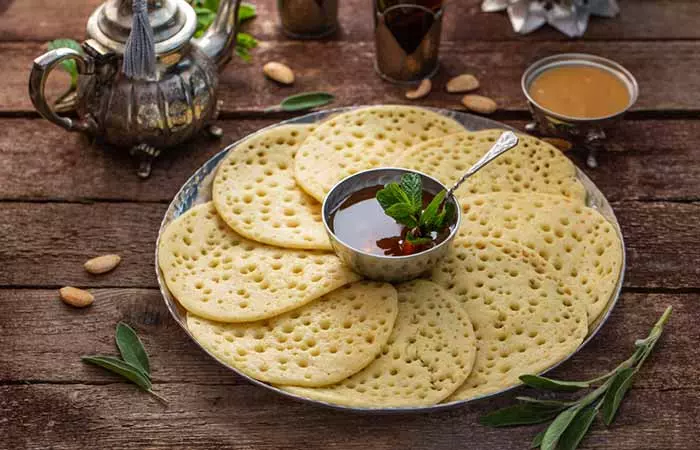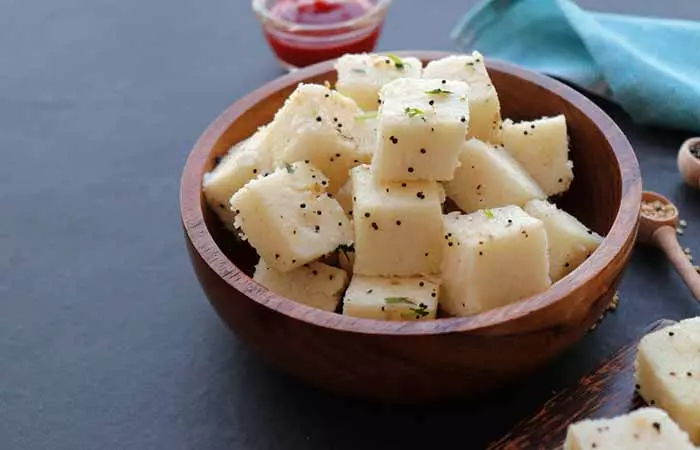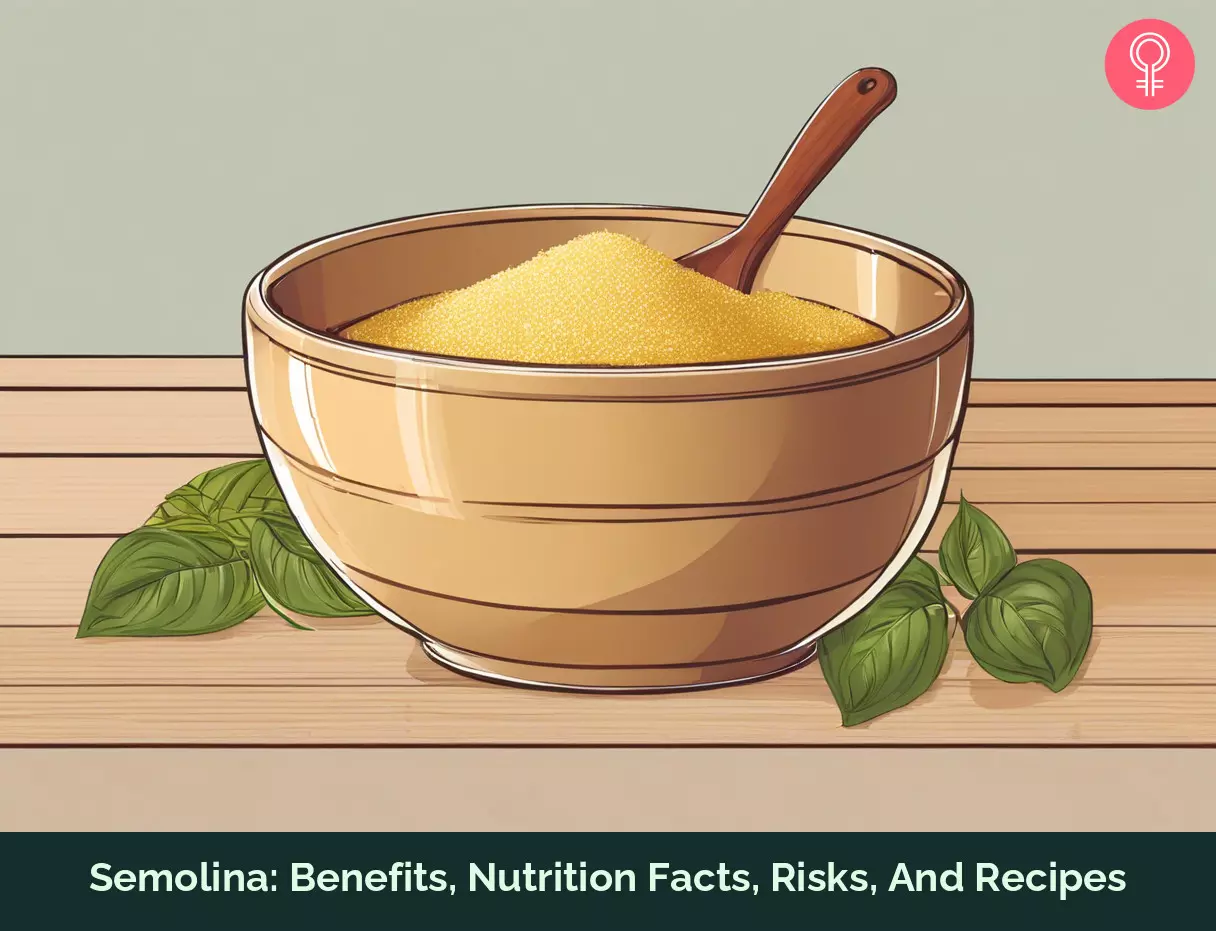What Is Semolina?
Semolina is flour made from the starchy endospermi A tissue produced inside the seeds of most flowering plants that surrounds and nourishes the embryo of the seeds. of durum wheat kernels. Like most grains, each durum wheat kernel has three main parts— the innermost nutrient-dense germ, the outermost bran, and the middle starchy endosperm. What Are Its Benefits? The fiber-rich semolina flour may help in weight loss, improve heart health, and digestive health, and help in regulating blood glucose levels. Who Can Consume It? It is safe for overall consumption but individuals who have Celiac disease should avoid it. How Often? You can consume it daily but in moderation. Caution Individuals who have wheat or gluten allergy should avoid consuming semolina.
Durum wheat is mainly grown in East and North Africa, West Asia, the North American great plains, and eastern and Mediterranean Europe. It is one of the hardest varieties of wheat and is mainly used to make coarse semolina flour. Scroll down to learn about semolina flour’s key nutrients and how they can be beneficial to us.
Semolina Nutrition Facts
Semolina flour can be available in its natural, unenriched form or enriched with added nutrients by food manufacturers. According to the USDA, 100 g of uncooked, unenriched, and enriched semolina can provide you with the following nutrients (1), (2). While most nutrient values remain the same, enriched semolina contains higher levels of iron, vitamins, and minerals than the unenriched alternatives (3). Semolina, with its high protein, vitamin, and mineral content can provide you with certain key health benefits. Let’s see what they are below.
Health Benefits Of Semolina
May Promote Weight Loss
Semolina is low in calories and has no cholesterol. However, if you plan to include semolina in your weight loss diet plan, then you should opt for whole-wheat semolina to get the benefits of fiber that aid in weight loss. Semolina is high in protein and fiber, both of which slow digestion and increase feelings of fullness between meals (4), (5). Studies suggest that a fiber-rich diet like semolina might help maintain lower body weight (6),(7). A study on women who took 1g more of dietary fiber each day, reported a loss of 0.25 kg over a period of 20 months (8). Semolina is also rich in protein with about 13 g of protein per 100 g of serving. A high-protein diet has been shown to be more effective in weight loss when compared to diets with standard protein content (9). It also helps maintain your muscle mass and improve your body composition while you are trying to lose weight (10).
May Help Support Heart Health
Whole wheat semolina, with its high fiber content, may reduce your risk of heart disease (11). A review of 31 studies found that people with a high intake of fiber may have up to a 24% reduced risk of heart disease (12). Fiber may also support heart health by lowering LDL (bad) cholesterol, blood pressure, and overall inflammation (13), ( 14). Additionally, enriched semolina is a good source of iron, magnesium, and folate (2). While iron balance is important to maintaining good cardiovascular health, a 100 mg increase in dietary magnesium can help reduce the risks of heart failure and stroke significantly (15), (16). Similarly, a high intake of folate was also associated with a 38% reduced risk of heart disease (17).
May Improve Blood Sugar Control
With its high levels of dietary fiber and magnesium, semolina may help improve blood sugar control and reduce the risk of diabetes (18), (19), ( 20). Fiber slows down the absorption and breakdown of carbs in your bloodstream. This helps control the blood sugar spikes after a meal. It can also lower fasting blood sugar levels in people who have diabetes already (21).
May Help Improve Digestive Health
Raw unenriched semolina contains about 4 g of fiber per 100 g of serving. Dietary fiber stimulates the growth of friendly bacteria in your digestive tract. This maintains a healthy balance of gut microbiotai The range of microorganisms like bacteria, fungi, viruses, and other organisms found in a person’s gastrointestinal system. and results in optimal digestion, good immunity, and improved metabolism (22), (23). Additionally, a fiber-rich diet helps add bulk to your digestive waste and promotes regularisation of your bowel movement. This helps ease symptoms of constipation and other digestive health issues. For instance, a two-week study found that people who ate 5 grams of additional whole-grain fiber daily had improvements in constipation and less bloating (24). While we can see the many health benefits of including semolina in your diet, there are a few associated concerns and risks as well.
Semolina Risks And Concerns
Not Whole Grain
In the process of making semolina, the outer fiber-rich bran and innermost nutrient-rich germ of the wheat kernels are usually removed. It is just the middle starchy endosperm with few of its proteins and vitamins, that is ground to make semolina. That makes semolina a processed, refined product without the benefits of the whole grain (unless mentioned whole durum wheat on the package). Regular refined semolina with its high carbohydrate content might not be a good meal option for those at risk for cardiovascular disease or Type 2 diabetes. You can opt for whole grain semolina instead. Studies state that whole grain food products help decrease the risk of cardiovascular disease and type 2 diabetes (25), (26). If you are at risk of type 2 diabetes or have any cardiovascular concerns, it is better to opt for whole-grain food options in place of semolina. While using semolina, you may look for and use whole-grain semolina.
Not Gluten-free
Semolina is rich in gluten and starch that makes it a good option for making bread, pasta, and other flour-based bakery products. But, if you have gluten sensitivity or celiac diseasei An inherited autoimmune digestive disorder that is triggered when you eat gluten, a protein found in wheat. , you should stay away from semolina (27). You may choose to use gluten-free options like buckwheat, amaranth, rice flour, or garbanzo beans in recipes that call for semolina. These options have tremendous benefits for overall health, making them a fantastic addition to your diet. For example, buckwheat helps manage diabetes, reduces constipation, lowers cholesterol levels, etc.
Wheat Allergy
As semolina is made from durum wheat, people allergic or sensitive to wheat should avoid having it. Allergic reactions could result in nausea, runny nose, sneezing, asthma, cramps, hives, etc (28). In case you suspect any such symptoms on consuming semolina, you should consult your doctor.
Semolina Recipes For Weight Loss
Semolina is a major component in most durum wheat pasta and can be made into a variety of preparations as per different cuisines. However, there are a few recipes that take advantage of the low calorie and no cholesterol content of semolina, making them favorable diet options for weight loss. Let’s know below how to make a few.
Moroccan Pancakes (Baghrir)
Ingredients
Water (warm) – 2 ½ cups Dry yeast – ½ tablespoon Semolina – 1 cup All-purpose flour – ½ cup Salt – to taste Baking powder – ½ tablespoon
Instructions
Suji (Semolina) Dhokla
Ingredients
Semolina (Suji flour) – 1 cup Sugar- ½ teaspoon Ginger paste- ½ teaspoon Green chili paste- ½ teaspoon Salt – 1 teaspoon Oil – 1 tablespoon Sour curd – ½ cup Water – ½ cup Baking soda – 1 teaspoon
For The Seasoning:
Mustard seeds – ½ teaspoon Curry leaves – 4-5 Green chillies (slit) – 2-3 Oil – 1 tablespoon Coriander – for garnish Coconut (grated) – for garnish
Instructions
Semolina Porridge
Ingredients
1 cup semolina 2 cups milk/water 2-3 tablespoons sugar (adjust to taste) A pinch of salt Optional flavorings such as grounded cinnamon or vanilla extract ½ cup chopped almonds
Instructions Clare, a blogger, used milk, semolina, caster sugar, butter, cinnamon, and nutmeg to prepare a warm pudding for her family during winter. She states in her blog, “I must say that I was pleasantly surprised with how my pudding turned out. The semolina tasted really light and warmed us all up (i). She adds that she served it with jam but suggests you may try it with chocolate, sultanas, and golden syrup. Apart from the above, there are a few other ways you can make the best of semolina in your kitchen.
Uses Of Semolina
Semolina is easily available in most grocery stores in the flour section. Rich in gluten, it is widely used in various types of pasta, bread, and other baked products for its tough and stretchy texture (29). Other than that, you may find semolina handy in the following ways:
Add a few teaspoons of semolina to your bread dough to give a crusty texture. Mix it into a pudding with milk, vanilla extract, and honey. Use the semolina in place of regular flour to make your dough recipes crispier. You can use it to thicken the consistency of a stew or sauce. Sprinkle some over while roasting potatoes or other veggies to make them crunchier.
To Sum Up
Semolina is the coarse, gluten-rich flour derived from the starchy middle layer of the durum wheat kernels. While semolina is essentially a refined flour, it can also be available in whole wheat and enriched versions. With a good amount of protein, vitamins, and important minerals, semolina benefits your heart, digestion, and blood sugar levels. This versatile flour is usually used in pasta, bread, bakery items, and other cooking recipes but can be added in other interesting ways to improve the taste and texture of various desserts, snacks, and savories. What can I use instead of semolina? Rice flour, kamut flour, amaranth flour, and garbanzo flour are good substitutes for semolina. Which is better – semolina or oats? Oats are better than semolina as they have more protein, fewer carbs, and more fat per calorie than Semolina (1), (2), (30). Does semolina cause gas? It may cause gas. Anecdotal evidence suggests that semolina could cause stomach discomfort, gas, constipation, or diarrhea in a few people. Are polenta and semolina the same? No. Polenta is derived from corn, while semolina is from wheat.
Illustration: Semolina: Benefits Nutrition Facts Risks And Recipes
Semolina has numerous health benefits and can be used to make delicious sweet and savory delicacies. Check out this video to discover its amazing benefits and get ready to be amazed!












